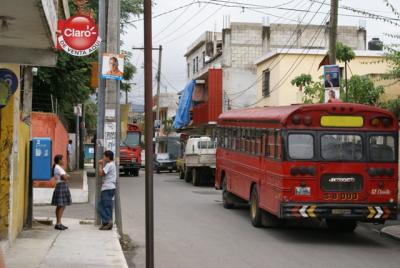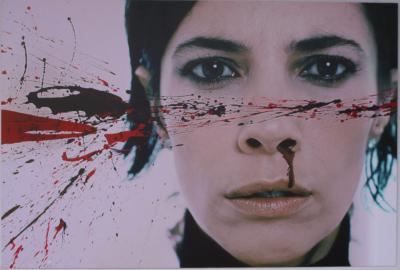Tuesday, 11. September 2007
pornography of violence
As two cars crash into each other on the highway, in the darkness of the night dismembered body parts of young, tall, beautiful ladies, like broken Barbie dolls, fall out through the broken windows or melt into a unitary lump of blood, flesh and metal. In his latest movie “Death Proof” Quentin Tarantino transgresses the furthest boundaries of his otherwise already sophisticated aesthetics of killing, where usually the rivals at least used to bow to each other. Whereas in “Planet Terror” Robert Rodriguez depicts how a small number of ideal superheroes, as if descended out of a comics book, fights with the expanding masses of humans turned into monsters as they are infected by a biochemical weapon.

The name of the project that Rodriguez and Tarantino co-authored – “Grindhouse” – comes from movie theatres, widespread in the United States, that show low budget category B films, attracting prurient viewers by the excessive depiction of redundant violence, forbidden sex, chaos, rebellions, monsters and drugs. It is a parody, which many leave with a feeling of strength as in the end evil is defeated. But that is only a movie. There are places in the world, where violence and paranoia are daily experiences. And these are not necessarily war zones. The worst is that once you step into such a land, the same weird feeling of voyeurism overcomes you as if you had just entered a movie theater showing a film of pornographic violence.

Tarantino could have vacation in Guatemala, where, even though the civil war ended eleven years ago, experiments with people equal to or even exceed the very fragile boundaries of death aesthetics in the movie industry. A couple of years ago Amnesty International made a press release when the authorities found what was left of the body once known as Maria Isabel: her hands and legs were tied with barbed wire, she had been raped, stabbed and strangled, her face disfigured from beating, the whole body covered with small holes, a rope around her neck, nails bent back. They never found her killers. Some years later Cristina Hernandez, forced into a car near her house, and hopelessly chased by her father, was found shot four times and all bitten.
In similar uncanny ways thousands of women have been tortured, raped and killed in Guatemala over the last few years. Why? During dinner in Zone 7 Rafael, who quit working for the municipality after his files have been stolen, told me about the gangs, tracing their origins in L.A. and other U.S. cities, their brutal inner-wars, the fate of their girlfriends in case of betrayal or jealousy, family vendettas, when they keep killing the women in the family of the indebted man until he returns the money. Finally, some victims are accidental, as one private interpreter recalls, because when a new member is initiated into a gang, he has to kill whoever they encounter first and in late evenings it is usually single women coming home from work through the dark streets of the slums that they meet. Unable to find definite data, sociologists explain the phenomenon by reducing it to the discontent of the macho society as daughters, sisters, wives and mothers independently climb up the social ladder...
Rodriguez would also have something to admire in Guatemala. The fear of violence, turned into paranoia, is ever-present in the capital, divided into twenty-five zones. The rich and the visitors live in private compounds outside of the city or in Zona Viva (“live zone”), where the streets between the hotels, restaurants and bars are patrolled by gunmen with carbines, where most buildings, even their inner yards, cultural and health institutions, are surrounded by a concrete wall with barbed wire fence on the top and armed guards at the gates. It is a ghetto city, divided no longer by ethnic, but by social boundaries: the walls and the fence are expensive. If today someone was to paint Guatemala City, most likely it would resemble the triptych by Hieronymus Bosch, entitled “Hay Wain” (1485-1490): there and then the avarice of mundane wealth lead people to madness, discord, deception, violence, murder; here and now burglars and rapists climb over the walls into the houses of those that have more, destroying everything on their way.
According to the results of a survey, that were announced in August 2007 and printed on the front page of “Siglo XXI”, 93.1 percent of Guatemalans are very concerned with the safety of themselves and their families. Those living in the capital often talk of the “banalizzacione di violencia”, or trivialization of violence, as it appears to be an inseparable part of everyday life. While we were tasting “Gallo” in the street just outside the fortified Universidad Landivar, a girl ran past us, grabbed her umbrella and pointed it as a gun towards her mother. A perfect pose, no reflection. But is reflection possible at all where violence is so endemic? 64.1 percent of the inhabitants claim that they or someone close to them have been victims of a crime; 23.6 percent choose not to leave home at night.
Scars are not the only form in which violence is imprinted on the bodies of the torturing and the tortured. Tattoos of black tears on the face count the dead loved ones; black crosses mark the killed ones. Following the ancient principle of lex talionis, or “an eye for an eye”, immortalized in the Code of the Babylonian king Hammurabi, no longer exposing their tears and crosses in the public, but hiding them on their hands or legs members of gangs don’t ask for the intervention by the corrupt and incompetent police. Away from the city, in rural areas, not receiving attention from the authorities local crowds lynch whomever they perceive as a criminal.
However, such society with a face, distorted by injustice, inequality, violence, appeals to the outsider, as if he entered the same cheap film, insanely stuffed with the scenes of killing and sex. Then in every passerby in the streets of Guatemala City you start recognizing the fear, which filled the eyes of the running hero in Mel Gibson’s “Apocalypto” as the Maya civilization was collapsing. Paranoia, sleepless fear that lingers in the air, danger, endemic, vulgarized violence. And poverty. Brazilians can’t stop laughing at tourists coming to Rio de Janeiro and willing to visit the infamous favelas, controlled by drug gangs; that is, leave the beaches of Copacabana and Ipanema and see the purportedly authentic, because hidden, local life, advertised by CNN and BBC news reports on the problems of “developing” “Third World” countries.
So the lens of the camera is looking for, finds and catches homeless mothers surrounded by hungry children begging for cash on the sidewalks, toothless tramp preparing dinner in a metal bin by the highway, a dozen or two men crowded in the truck on their way to work in the mines. And then – run. Reality, authentic being is recorded and eternalized in the photograph. It is dangerous to stay because angry “models” can rebel and channel their fury towards the fancy digital toy and its owner. Hungry and dirty, like the monsters in Rodriguez’s movie, the “authentic” locals attack. The tourist, who provoked them by looking for real, unmediated experiences, even if robbed or beaten up, is happy to come home and tell stories of a wild and dangerous land he got out of.
Such perverse indulging in social inequality, poverty, violence and other troubles of men is usually denied and disguised by the Marxist slogans of solidarity with the suffering people, often written on the T-shirt just below the portrait of the Argentinean revolutionary. The voyeur is caught onto his own hook as the victims of his lens are suffering twice from the same hand, which first brought racist government, uncontrollable neoliberalism and illnesses, and now broadens his mind and enriches his experiences by the apocalyptic sight of their consequences.
If Tarantino and Rodriguez are mocking cheap movies, intended to satisfy the lusts of violence and sex, therefore, are adding a new layer of meaning to the superficial fiction on the screen and so are creating a point of reference for reflection, the pornography of violence as a searched-for authentic experience in Bronx, Kosovo, Belfast, Mexico, Beirut, Detroit and anywhere else, where there are beaten, starving, naked, armed, scarred, angry, lame, begging for a pittance, confirms the insurmountable wall between the viewer and the object of his malaise-seeking sight. The glass wall of the lens is not a mirror, therefore, in the postcards from exotic places we only see dark smiling kids waiving their hands at us. I am not there, because to be close to them is too demanding. I am not there, because I am not reflecting it. I am not there, because for me it is enough to quote what has already been said by the enemies of America and the capitalist world. And nothing more? On the wall of an expensive colonial restaurant in the former capital of the Spanish colonies one can read: Unos nacieron para moler y otros para ser molidos (“Some were born to crush and some to be crushed”).
More photos: http://picasaweb.google.com/ieva.jusionyte/DiezDiasEnGuatemala

The name of the project that Rodriguez and Tarantino co-authored – “Grindhouse” – comes from movie theatres, widespread in the United States, that show low budget category B films, attracting prurient viewers by the excessive depiction of redundant violence, forbidden sex, chaos, rebellions, monsters and drugs. It is a parody, which many leave with a feeling of strength as in the end evil is defeated. But that is only a movie. There are places in the world, where violence and paranoia are daily experiences. And these are not necessarily war zones. The worst is that once you step into such a land, the same weird feeling of voyeurism overcomes you as if you had just entered a movie theater showing a film of pornographic violence.

Tarantino could have vacation in Guatemala, where, even though the civil war ended eleven years ago, experiments with people equal to or even exceed the very fragile boundaries of death aesthetics in the movie industry. A couple of years ago Amnesty International made a press release when the authorities found what was left of the body once known as Maria Isabel: her hands and legs were tied with barbed wire, she had been raped, stabbed and strangled, her face disfigured from beating, the whole body covered with small holes, a rope around her neck, nails bent back. They never found her killers. Some years later Cristina Hernandez, forced into a car near her house, and hopelessly chased by her father, was found shot four times and all bitten.
In similar uncanny ways thousands of women have been tortured, raped and killed in Guatemala over the last few years. Why? During dinner in Zone 7 Rafael, who quit working for the municipality after his files have been stolen, told me about the gangs, tracing their origins in L.A. and other U.S. cities, their brutal inner-wars, the fate of their girlfriends in case of betrayal or jealousy, family vendettas, when they keep killing the women in the family of the indebted man until he returns the money. Finally, some victims are accidental, as one private interpreter recalls, because when a new member is initiated into a gang, he has to kill whoever they encounter first and in late evenings it is usually single women coming home from work through the dark streets of the slums that they meet. Unable to find definite data, sociologists explain the phenomenon by reducing it to the discontent of the macho society as daughters, sisters, wives and mothers independently climb up the social ladder...
Rodriguez would also have something to admire in Guatemala. The fear of violence, turned into paranoia, is ever-present in the capital, divided into twenty-five zones. The rich and the visitors live in private compounds outside of the city or in Zona Viva (“live zone”), where the streets between the hotels, restaurants and bars are patrolled by gunmen with carbines, where most buildings, even their inner yards, cultural and health institutions, are surrounded by a concrete wall with barbed wire fence on the top and armed guards at the gates. It is a ghetto city, divided no longer by ethnic, but by social boundaries: the walls and the fence are expensive. If today someone was to paint Guatemala City, most likely it would resemble the triptych by Hieronymus Bosch, entitled “Hay Wain” (1485-1490): there and then the avarice of mundane wealth lead people to madness, discord, deception, violence, murder; here and now burglars and rapists climb over the walls into the houses of those that have more, destroying everything on their way.
According to the results of a survey, that were announced in August 2007 and printed on the front page of “Siglo XXI”, 93.1 percent of Guatemalans are very concerned with the safety of themselves and their families. Those living in the capital often talk of the “banalizzacione di violencia”, or trivialization of violence, as it appears to be an inseparable part of everyday life. While we were tasting “Gallo” in the street just outside the fortified Universidad Landivar, a girl ran past us, grabbed her umbrella and pointed it as a gun towards her mother. A perfect pose, no reflection. But is reflection possible at all where violence is so endemic? 64.1 percent of the inhabitants claim that they or someone close to them have been victims of a crime; 23.6 percent choose not to leave home at night.
Scars are not the only form in which violence is imprinted on the bodies of the torturing and the tortured. Tattoos of black tears on the face count the dead loved ones; black crosses mark the killed ones. Following the ancient principle of lex talionis, or “an eye for an eye”, immortalized in the Code of the Babylonian king Hammurabi, no longer exposing their tears and crosses in the public, but hiding them on their hands or legs members of gangs don’t ask for the intervention by the corrupt and incompetent police. Away from the city, in rural areas, not receiving attention from the authorities local crowds lynch whomever they perceive as a criminal.
However, such society with a face, distorted by injustice, inequality, violence, appeals to the outsider, as if he entered the same cheap film, insanely stuffed with the scenes of killing and sex. Then in every passerby in the streets of Guatemala City you start recognizing the fear, which filled the eyes of the running hero in Mel Gibson’s “Apocalypto” as the Maya civilization was collapsing. Paranoia, sleepless fear that lingers in the air, danger, endemic, vulgarized violence. And poverty. Brazilians can’t stop laughing at tourists coming to Rio de Janeiro and willing to visit the infamous favelas, controlled by drug gangs; that is, leave the beaches of Copacabana and Ipanema and see the purportedly authentic, because hidden, local life, advertised by CNN and BBC news reports on the problems of “developing” “Third World” countries.
So the lens of the camera is looking for, finds and catches homeless mothers surrounded by hungry children begging for cash on the sidewalks, toothless tramp preparing dinner in a metal bin by the highway, a dozen or two men crowded in the truck on their way to work in the mines. And then – run. Reality, authentic being is recorded and eternalized in the photograph. It is dangerous to stay because angry “models” can rebel and channel their fury towards the fancy digital toy and its owner. Hungry and dirty, like the monsters in Rodriguez’s movie, the “authentic” locals attack. The tourist, who provoked them by looking for real, unmediated experiences, even if robbed or beaten up, is happy to come home and tell stories of a wild and dangerous land he got out of.
Such perverse indulging in social inequality, poverty, violence and other troubles of men is usually denied and disguised by the Marxist slogans of solidarity with the suffering people, often written on the T-shirt just below the portrait of the Argentinean revolutionary. The voyeur is caught onto his own hook as the victims of his lens are suffering twice from the same hand, which first brought racist government, uncontrollable neoliberalism and illnesses, and now broadens his mind and enriches his experiences by the apocalyptic sight of their consequences.
If Tarantino and Rodriguez are mocking cheap movies, intended to satisfy the lusts of violence and sex, therefore, are adding a new layer of meaning to the superficial fiction on the screen and so are creating a point of reference for reflection, the pornography of violence as a searched-for authentic experience in Bronx, Kosovo, Belfast, Mexico, Beirut, Detroit and anywhere else, where there are beaten, starving, naked, armed, scarred, angry, lame, begging for a pittance, confirms the insurmountable wall between the viewer and the object of his malaise-seeking sight. The glass wall of the lens is not a mirror, therefore, in the postcards from exotic places we only see dark smiling kids waiving their hands at us. I am not there, because to be close to them is too demanding. I am not there, because I am not reflecting it. I am not there, because for me it is enough to quote what has already been said by the enemies of America and the capitalist world. And nothing more? On the wall of an expensive colonial restaurant in the former capital of the Spanish colonies one can read: Unos nacieron para moler y otros para ser molidos (“Some were born to crush and some to be crushed”).
More photos: http://picasaweb.google.com/ieva.jusionyte/DiezDiasEnGuatemala
ieva jusionyte, 22:52h
... link (0 Kommentare) ... comment
Saturday, 11. August 2007
for cats and dogs
on the US Airways plane from Dublin to Boston, i grabbed the SkyMall magazine, offering to buy everything, from Harry Potter chess set to shoes and watches, and found so many amazing advertisements for cats and dogs, that i couldn't help taking the magazine with me. here is a short list of the items:

- "advanced large-capacity feline drinking fountain" (a water bowl for cats, developed by a veterinarian with a help of an animal behaviorist, which continuously circulates water like in a fountain);
- various shapes and sizes pet gates to confine dogs in a designated area of the room or a house, as well as backseat barriers for cars;
- dog bed;
- "super bark free", a gadget that controls barking by automatically sending ultrasonic tones heard only by dogs, considered to be "a safe and humane way to control barking";
- "dog dazer" to protect against hostile dogs, which creates an uncomfortable high-frequency sound audible to dogs, but not to humans;
- decorative litter box for cats, hidden in a clay pot for flowers;
- several pet travel sets, including a climate-controlled per carrier;
- cat toilet, equivalent to the one we use, which is connected to the water supply system and flushes away cat waste with the press of the button;
- "radio rodent" for cats to chase, radio-controlled and red-eyed;
- "pet trainer", which starts alarm as soon as your pet tries to get on the sofa or any other place it is forbidden to touch;
- dog stairs, that help "small breeds, senior pets and dogs with arthritis or hip trouble" to climb up to the furniture or bed;
- gadget, which automatically feeds your cat or dog with small portions of food and water according to a set timetable;
etc...
more pictures and exhilarating descriptions from the online version of the magazine: http://www.skymall.com/shopping/dept.htm?c=10700

- "advanced large-capacity feline drinking fountain" (a water bowl for cats, developed by a veterinarian with a help of an animal behaviorist, which continuously circulates water like in a fountain);
- various shapes and sizes pet gates to confine dogs in a designated area of the room or a house, as well as backseat barriers for cars;
- dog bed;
- "super bark free", a gadget that controls barking by automatically sending ultrasonic tones heard only by dogs, considered to be "a safe and humane way to control barking";
- "dog dazer" to protect against hostile dogs, which creates an uncomfortable high-frequency sound audible to dogs, but not to humans;
- decorative litter box for cats, hidden in a clay pot for flowers;
- several pet travel sets, including a climate-controlled per carrier;
- cat toilet, equivalent to the one we use, which is connected to the water supply system and flushes away cat waste with the press of the button;
- "radio rodent" for cats to chase, radio-controlled and red-eyed;
- "pet trainer", which starts alarm as soon as your pet tries to get on the sofa or any other place it is forbidden to touch;
- dog stairs, that help "small breeds, senior pets and dogs with arthritis or hip trouble" to climb up to the furniture or bed;
- gadget, which automatically feeds your cat or dog with small portions of food and water according to a set timetable;
etc...
more pictures and exhilarating descriptions from the online version of the magazine: http://www.skymall.com/shopping/dept.htm?c=10700
ieva jusionyte, 18:53h
... link (0 Kommentare) ... comment
Monday, 29. January 2007
Generation J?
Does it prove that a new Jewish subculture is emerging?

Eric Silverman, now an Associate Professor, who got an undergraduate degree in anthropology at Brandeis some twenty years ago, says it does. And since last week’s colloquium the anthropology faculty have been tearing him into pieces for lack of evidence – he hasn’t asked a single person actually wearing these clothing items what significance they attribute to them. It is only according to him that yarmulke with Mickey Mouse, Little Mermaid or Harry Potter and T-shirts or even underwear carrying “Eat Me, I’m Kosher” signs are means of identification for “Generation J” Jews.
Yes, the proliferation of this new production is an interesting phenomenon and some Brandeis students do wear similar T-shirts on Friday parties in the dorms. For fun? Because of pride? Aiming to change the conservatism of traditional Jewish culture? The reasons might be different. Only in one of the dozens of pictures of these products shown in the colloquium was Hitler mentioned. And there was one more reference to Jihad. Besides these two cases, it is obvious that the construction of this new identity is entirely self-referential, de-essentializing, re-contextualizing, maybe even treating with irony the core symbols of being Jewish. The new Jew is not created in opposition to the Other, be it a Nazi or an Islamic fundamentalist.
But Eric did not talk about this at all. He was jumping from one image to another, sometimes laughing, sometimes embarrassed to translate what the words in Hebrew mean for a majority of graduate students who do not come from a Jewish background. For the first time I saw how openly critical for methodological failures Brandeis professors can be. This might have been good enough as a project in cultural studies, but not in anthropology, one professor observed.
In any case the phenomenon itself is worth attention. The only question that I am worried about is: Isn't it just an assemblage of quite different things instead of a uniformed subculture? A yarmulke with Disney characters is not really the same as a "Mensch" T-shirt. Or is it?
Some websites with the products mentioned above:
http://www.cafepress.com/awesomeseminars
http://www.jewishbride.com/store/children_babies.html
http://www.kippah.com/





Eric Silverman, now an Associate Professor, who got an undergraduate degree in anthropology at Brandeis some twenty years ago, says it does. And since last week’s colloquium the anthropology faculty have been tearing him into pieces for lack of evidence – he hasn’t asked a single person actually wearing these clothing items what significance they attribute to them. It is only according to him that yarmulke with Mickey Mouse, Little Mermaid or Harry Potter and T-shirts or even underwear carrying “Eat Me, I’m Kosher” signs are means of identification for “Generation J” Jews.
Yes, the proliferation of this new production is an interesting phenomenon and some Brandeis students do wear similar T-shirts on Friday parties in the dorms. For fun? Because of pride? Aiming to change the conservatism of traditional Jewish culture? The reasons might be different. Only in one of the dozens of pictures of these products shown in the colloquium was Hitler mentioned. And there was one more reference to Jihad. Besides these two cases, it is obvious that the construction of this new identity is entirely self-referential, de-essentializing, re-contextualizing, maybe even treating with irony the core symbols of being Jewish. The new Jew is not created in opposition to the Other, be it a Nazi or an Islamic fundamentalist.
But Eric did not talk about this at all. He was jumping from one image to another, sometimes laughing, sometimes embarrassed to translate what the words in Hebrew mean for a majority of graduate students who do not come from a Jewish background. For the first time I saw how openly critical for methodological failures Brandeis professors can be. This might have been good enough as a project in cultural studies, but not in anthropology, one professor observed.
In any case the phenomenon itself is worth attention. The only question that I am worried about is: Isn't it just an assemblage of quite different things instead of a uniformed subculture? A yarmulke with Disney characters is not really the same as a "Mensch" T-shirt. Or is it?
Some websites with the products mentioned above:
http://www.cafepress.com/awesomeseminars
http://www.jewishbride.com/store/children_babies.html
http://www.kippah.com/




ieva jusionyte, 13:45h
... link (0 Kommentare) ... comment